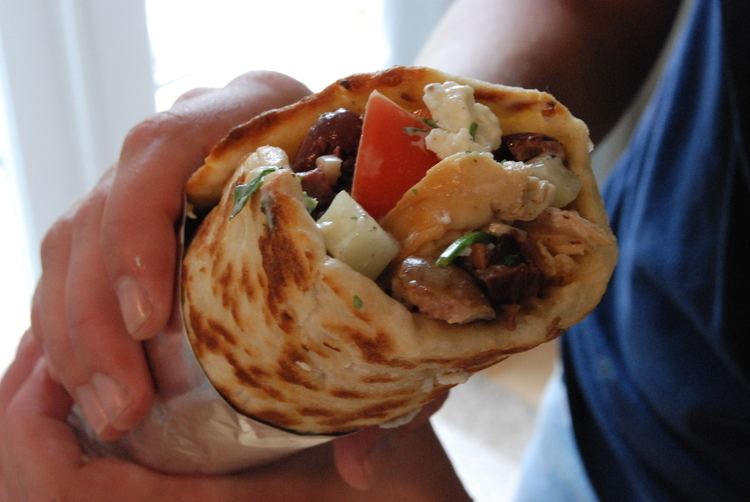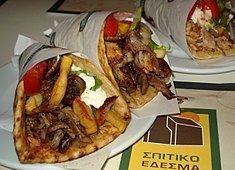Type Meat or sandwich Serving temperature Hot | Course Main dish Place of origin Greece | |
Main ingredients Meat: Beef, Veal, Mutton, Pork, or Chicken Similar Souvlaki, Tzatziki, Pita, Shawarma, Kebab | ||
A gyro or gyros ([ˈʝiros]) (Greek: γύρος, gyros, literally 'turn') is a Greek dish made of meat cooked on a vertical rotisserie, traditionally pork, or chicken, and outside of Greece with beef, veal, lamb, and usually served wrapped in a flatbread such as pita, with tomato, onion, and tzatziki sauce.
Contents

To make gyros, pieces of meat are placed on a tall vertical rotisserie, in the shape of an inverted cone, which turns slowly in front of a source of heat, usually an electric broiler. If the meat is not fatty enough, strips of fat are added so that the roasting meat always remains moist and crisp. The rate of roasting can be adjusted by varying the strength of the heat and the distance between the heat and the meat, allowing the cook to adjust to varying rates of consumption. The outside of the meat is sliced vertically in thin, crisp shavings when done. It is generally served in an oiled, lightly grilled piece of pita, rolled up with various salads and vegetables such as lettuce, as well as sauces, such as mustard. Gyros form part of the sandwich family and are differentiated from other hand-held semi-folded foods by their complete over-wrap but unsecured lower flap.

Name

The name comes from Greek γύρος ('turn'), meaning "turn"; it was originally called ντονέρ (pronounced [doˈner]) in Greek, from Turkish döner kebab. The word 'ντονέρ' was criticized in Greece for being Turkish, and the word 'gyros' was coined to replace it.

The Greek pronunciation is [ˈʝiros], but the pronunciation in English is often /ˈdʒaɪroʊ/ or, occasionally /ˈɡɪəroʊ/ or /ˈjɪəroʊ/. The final 's' of the Greek form is often reinterpreted as a plural in English, leading to the formation of the singular "gyro".
History
Though grilling meat on a skewer has ancient roots in the Eastern Mediterranean with evidence from the Mycenaean Greek and Minoan periods, grilling a vertical spit of stacked meat slices and cutting it off as it cooks was developed in the 19th century in Ottoman Bursa. According to some sources, the Middle Eastern shawarma, Mexican tacos al pastor, and Greek gyros are all derived from the Turkish döner kebab, which was invented in Bursa in the 19th century by a cook named Hadji Iskender.
By 1971, gyros was already popular in Athens and in New York City. The earliest known American gyros meat mass-production plant was opened by John Garlic in Milwaukee. He later sold his interest in the business to Gyros, Inc. of Chicago, which along with Central Gyros Wholesale, and Kronos Foods, Inc, also of Chicago, began large-scale production in the mid-1970s.
Preparation
Gyros are cooked on a vertical broiler, formerly using charcoal in a "cage", now either gas or electric. As the cone cooks, lower parts are basted with the juices running off the upper parts.
Traditionally the meat used is pork or chicken, while in restaurants outside of Greece, lamb is commonly used. The meat is cut into approximately round, thin, flat slices, which are then stacked on the spit and seasoned. Fat trimmings are usually interspersed.
Spice mixes generally include salt, hot and sweet paprika, white and black pepper, dried parsley, garlic powder, and oregano. Additional spices are sometimes added (e.g. cinnamon, nutmeg, cumin, anise, coriander, fennel, allspice, sumac).
The rate of cooking can be changed by altering the intensity of the fire, the proximity of the meat to the heat source, and the speed of the spit rotation.
